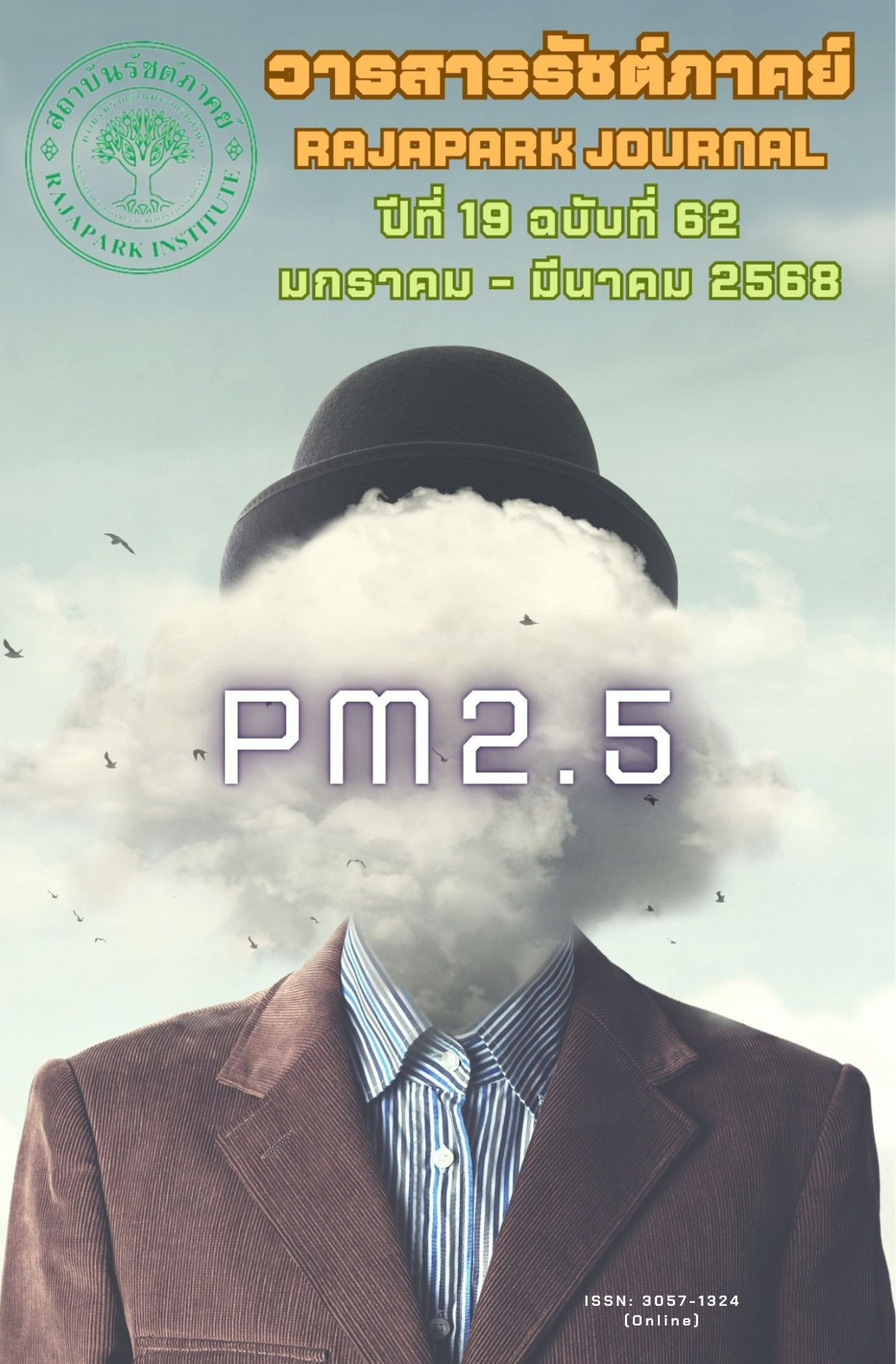Causal Factors of Service Quality Affecting Perceived Value and Decision-Making of Mu Te Lu Tourism Travelers in Nong Khai, Bueng Kan, and Udon Thani Provinces
Main Article Content
Abstract
The purposes of this research are to 1) study the components of service quality in Mu Te Lu temples that influence tourists’ value perception and their decision to travel to pay respects to sacred beings and 2) develop a causal factor model of service quality that impacts the value perception and decision-making of Mu Te Lu tourists in the provinces of Nong Khai, Bueng Kan, and Udon Thani. This quantitative research uses convenience sampling to collect data from 400 tourists visiting Mu Te Lu attractions in Nong Khai, Bueng Kan, and Udon Thani provinces. The research instrument used was a questionnaire analyzed using frequency, percentage, mean, and standard deviation. Data analysis was conducted using Structural Equation Modeling (SEM). The research findings revealed that the service quality dimensions of Mu Te Lu temples consist of five dimensions: reliability, assurance, tangibles, empathy, and responsiveness. These dimensions, directly and indirectly, affect value perception and the decision to travel to Mu Te Lu destinations with statistical significance at the 0.01 and 0.001 levels. The results of this study are beneficial both academically and practically, providing jobs and livelihoods to the surrounding community and society. Additionally, these research findings can be used as a benevolent policy to invite Mu Te Lu tourists and other individuals to visit temples while incorporating Dhamma teachings, which will promote sustainable tourism and distribute income to local communities.
Article Details

This work is licensed under a Creative Commons Attribution-NonCommercial-NoDerivatives 4.0 International License.
Views and opinions appearing in the Journal it is the responsibility of the author of the article, and does not constitute the view and responsibility of the editorial team.
References
Baker, D. A., & Crompton, J. L. (2000). Quality, satisfaction, and behavioral intentions. Annals of Tourism Research, 27(3), 785-804. https://doi.org/10.1016/S0160-7383(99)00108-5
Choi, T. Y., & Chu, R. (2001). Determinants of hotel guests’ satisfaction and repeat patronage in the Hong Kong Hotel Industry. International Journal of Hospitality Management, 20(3), 277-297. https://doi.org/10.1016/S0278-4319(01)00006-8
Cronin, Jr., J. J., & Taylor, S. (1992). Measuring service quality: a reexamination and extension. The Journal of Marketing, 56, 55-68. https://doi.org/10.2307/1252296
Hair, J.F., Black, W.C., Babin, B.J., & Anderson, R.E. (2010). Multivariate data analysis (7th ed.). Pearson.
Heritage Council of Western Australia. (2022). Local heritage survey 2022. https://engage.perth.wa.gov.au
Hennig-Thurau, T., Gwinner, K.V., Walsh, G., & Gremler, D.D. (2004). Electronic word-of-mouth via consumer-opinion platforms: What motivates consumers to articulate themselves on the Internet?. Journal of Interactive Marketing, 18(1), 38-52. https://doi.org/10.1002/dir.10073
Jansuri, A. (2021). Mutelu: beliefs and tourism. Journal of Thithat Watthanatham, 20(1), 220-240.
Lai, I.K.W., & Hitchcock, M. (2016). A comparison of service quality attributes for stand-alone and resort-based luxury hotels in Macau: 3-Dimensional importance performance analysis. Tourism Management, 55, 139-159. DOI:10.1016/j.tourman.2016.01.007
Kusumawati, A., Rahayu, K.S., & Putra, E.W. (2022). Antecedents customer decision to visit Yogyakarta as special regions in Indonesia. Cogent Business and Management, 9(1), 2050062. DOI:10.1080/23311975.2022.2050062
Kannan, R. (2020). Perception towards significance of holy places and revisiting intention of religious tourists in Himachal Pradesh. Medicine, 7(6), 441-448.
Lewis, R. C., & Booms, B. H. (1983). The marketing aspects of service quality. In L. Berry, G. L. Shostack, & G. D. Upah (Eds.), Perspectives on Services Marketing (pp. 99-107). Chicago: American Marketing Association.
Liu, C.H.S., & Lee, T. (2016). Service quality and price perception of service: Influence on word-of-mouth and revisit intention. Journal of Air Transport Management, 52, 42-54. https://doi.org/10.1016/j.jairtraman.2015.12.007
Mohamad, M., Ali, A.M., & Ghani, N.I. (2011). A structural model of destination image, tourists' satisfaction and destination loyalty. The International Journal of Business and Management, 3, 167-177. https://dergipark.org.tr/en/download/article-file/255953
Nguyen-Phuoc, D.Q., Su, D., Tran, P.K.T., Le-Klähn, D-T., & Johnson, L.W. (2020). Factors influencing customer’s loyalty towards ride-hailing taxi services-A case study of Vietnam. Transportation Research Part A: Policy and Practice, 134(1), 96-112.
DOI:10.1016/j.tra.2020.02.008
Nunnally, J.C. (1978). Psychometric theory. McGraw-Hill.
Office of the National Economic and Social Development Council. (2024). Transportation concepts and theories. Office of the Prime Minister, Thailand.
Parasuraman, A., Zeithaml, V.A., & Berry, L. (1985). A conceptual model of service quality and its implications for future research. Journal of Marketing, 49, 41-50. http://dx.doi.org/10.2307/1251430
Parasuraman, A., Zeithaml, V.A., & Berry, L.L. (1988). SERVQUAL: A multiple-item scale for measuring consumer perceptions of service quality. Journal of Retailing, 64, 12-40.
Poltanee, I., & Boonphetkaew, U. (2018). A study on potential of tourist attractions on Tao Island in Surat Thani Province as a guideline to promote sustainable tourism. Silpakorn University e-Journal (Social Sciences, Humanities, and Arts), 38(5), 18-39. https://so05.tci-thaijo.org/index.php/sujthai/article/view/152558
Rohman, I.Z. (2021). What creates tourist satisfaction in Prambanan temple?. KINERJA, 25(2), 151-163. DOI:10.24002/kinerja.v25i2.4362
Schmolling, A., & Saraphat, S. (2021). The effect of flexibility and service innovation in 5 traditional passenger car manufactures in Thailand on performance of dealers’ standardized automotive aftersales service centers. Journal of Graduate School of Commerce-Burapha Review, 16(1), 29-42. https://so02.tci-thaijo.org/index.php/GSC/article/view/244803
Taokaecafe. (2020). Praewa amulet and lucky stone. https://www.taokaecafe.com/sme-business-detail?s=143
Timothy, D. J., & Boyd, S. W. (2003). Heritage tourism. Prentice Hall.
Thanin Silpjaru. (2024). Research and statistical data analysis using SPSS. We Inter Print.
UNWTO. (2018). Sustainable tourism: definition and practices. United Nations World Tourism Organization.
Vanichbuncha, K. (2024). Statistics for research (15th ed.). Samlada.
Western, S. (2008). Leadership: a critical text. SAGE.
Yu, S., & Lee, J. (2019). The effects of consumers’ perceived values on intention to purchase upcycled products. Sustainability, 11(4), 1034. https://doi.org/10.3390/su11041034
Zeithaml, V. A. (1988). Consumer perceptions of price, quality, and value: A means-end model and synthesis of evidence. Journal of Marketing, 52(3), 2-22. http://dx.doi.org/10.2307/1251446


